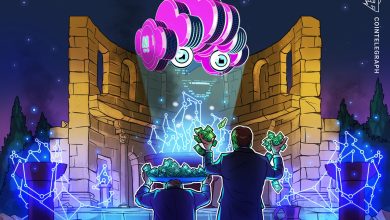The cryptocurrency industry has evolved significantly, driven by innovations in finance

The cryptocurrency industry has evolved significantly, driven by innovations in decentralized finance (DeFi) and blockchain technology. Amid this shift, Waves founder Sasha Ivanov introduced the modular network. Designed as a foundation layer, the Units Network connects ecosystem chains in a fully interoperable, trustless manner, featuring any asset recovery and security with real-world assets (RWA).
In this interview, Ivanov discusses the strategies and innovations behind Units Network, its role in the Waves ecosystem and the broader implications of blockchain technology. It also reflects on past challenges, including the decoupling of the US dollar neutrino and the impact of the FTX collapse, and provides valuable insights into the future of DeFi.
Cointelegraph: What do you have in store for the next bull cycle?
Sasha Ivanov: We are launching a new project, Units Network, based on the Waves ecosystem. The goal is to grow the ecosystem significantly and bring in new members of the community. This project enables launching your own Layer 1 (L1) blockchain based on the Waves System (WAVES). The network is fully compatible with Ethereum and aims to simplify launching your own blockchain network.
Also, networks within the ecosystem interact through the Waves network, which becomes more than just an L1 blockchain but represents the foundational level of Layer 0 (L0) of the ecosystem. We believe that the ease of launching blockchain networks and their efficient connection to existing networks is the key to the mass adoption of blockchain technology.
#waves It will become a chain that supports dozens of chains built on top of it $waves Miners benefit from mining the native tokens of all those chains.
This setup is unique, and your Waves mining rewards (which aren't too bad now either) will increase several times.
– Sasha.waves (@sasha35625) April 13, 2024
CT: How did you deal with wave-related challenges, what were the outcomes, and what lessons did you learn from this situation?
C: The past two years have been very challenging for all of us, and Waves has had many unpleasant issues as well, but of course they pale in comparison to what's going on in the world.
On the positive side, we can highlight the following: The USDN fork and similar stablecoin issues have shown that a model that relies solely on market mechanisms to maintain the stability of these assets is not stable enough and is vulnerable to attacks (such mechanisms may work). In 99% of situations, but the unexpected 1% can undermine the entire model.)
Furthermore, through the example of Waves, we have demonstrated that decentralized autonomous organization (DAO) models can work in crisis situations. After the situation with USDN and the stranded liquidity in the loan protocol on Waves and Waves Exchange gateways, the possibility of central funding for the development of core ecosystem products has disappeared. The Waves ecosystem is now fully decentralized, with all funding done through the Waves DAO, allowing Waves to continue its development.
CT: How did the conflict with Alameda Research impact Waves? What are your thoughts on the FTX exchange collapse?
C: “What doesn't kill us makes us stronger.” My attitude towards the cryptocurrency market and my vision of what I aim to achieve in it has changed dramatically. The collapse of FTX was a huge surprise to me and opened my eyes to risks within the Western financial system, which I had tended to underestimate.
CT: How do you evaluate the current approach to development and scalability of Ethereum?
C: The Units Network aims to do what Ethereum is likely to do in the coming years – connect Layer 2 (L2) and Ethereum core networks into a single ecosystem based on Ether (ETH) storage. In this case, the L2 networks essentially become “shards” of Ethereum, and the shards will get a new life within the future Ethereum ecosystem.
I believe this is the end game of the current development of crypto technologies – an ecosystem based on the economic mechanisms of a strong L1 network with L2 networks using these mechanisms to achieve decentralization and interoperability internally. In this scenario, the L1 network essentially becomes the L0, the core level that provides consensus and connects all networks into a single ecosystem.
CT: Can you give us an overview of the module network and its role in the blockchain ecosystem?
C: The modules aim to grow the Waves ecosystem by providing the ability to launch Ethereum Virtual Machine (EVM) networks quickly and efficiently. This bypasses the need to deploy individual validators and allows networks to communicate with others inside and outside the ecosystem. It is expected that there will be hundreds of interconnected EVM networks within the ecosystem, with the first Unit0 network being central. Its Unit0 token governs DAO units within the ecosystem.
We are launching a Units testnet campaign, which allows users to learn about the product and earn rewards for testnet activities. This will be followed by a staking campaign, where users can earn unit tokens to provide liquidity. The units are expected to be launched in June and July this year.
🧱What if cubes were used to lay the foundation for infrastructure aimed at addressing the blockchain issues we discussed earlier? Units can do more! But first, let's shed some light on some background.
In the blockchain industry, there is a lot of talk about layer one and layer one… pic.twitter.com/0oqKcs2DqZ
— Units.Network (@UnitsNetwork) March 21, 2024
CT: Can you walk us through some of the specific tools and solutions that Modular Network offers?
C: Units Network's goal is to enable a very clear process for launching your own blockchains. The blockchain creator submits a proposal for DAO governance, offering certain rewards to network validators. If the proposal is approved, their blockchain will be launched within a few days. You don't need to maintain your own nodes. The new blockchain is supported by the existing validator community and is seamlessly connected and fully interoperable with all other chains within the ecosystem. Furthermore, external bridges provide connectivity to other ecosystems.
CT: How does the Hybrid RWA stablecoin system work, and what are its benefits compared to traditional stablecoins?
C: RWA listing is very important for future applications of blockchain technology because it promises to move a significant portion of the global financial infrastructure to blockchain technology and could provide an almost unlimited flow of new projects for years to come. On the other hand, the RWA narrative requires lowering entry barriers for projects, especially when launching their own blockchains.
The modules will facilitate the launch of several RWA projects in the ecosystem, with the aim of showcasing the advantages of the network in terms of ease of launch and connectivity to the external ecosystem. One of the projects that will be launched is a hybrid RWA stablecoin that combines crypto collateral with less liquid RWA collateral such that the RWA part provides an annual stablecoin return (APY), and the crypto part secures the stablecoin peg.
CT: From a user perspective, what are the tangible advantages of using Units Network over traditional blockchain platforms?
C: We focus on the simplicity of launching your own chain, built into the existing ecosystem with useful features such as internal bridges for custodians, external bridges with native stake for any assets and an ecosystem DAO system that can help bootstrap your own chain. The goal is to create a Swiss army knife type solution to unlocking and maintaining your block space for all kinds of projects that require it and make it truly accessible to everyone.
CT: Looking to the future, what are the future plans for the modular network?
C: Currently, we are initiating testnet and liquidity campaigns aimed at showcasing the features of the Unity network. The mainnet of the ecosystem's first blockchain system, Unit0, is scheduled to launch this summer. The next important milestone for Units is the launch of the DAO ecosystem based on the Unit0 token. This will help bootstrap more ecosystem chains and launch decentralized applications on the Unit0 chain. In parallel, zero-knowledge (ZK) proofs will be integrated into the ecosystem, allowing different approaches to L0-L1 interoperability.
Disclaimer. Cointelegraph does not endorse any content or product on this page. While we aim to provide you with all the important information we can in this sponsored article, readers should conduct their own research before taking any actions regarding the company and take full responsibility for their decisions, and this article cannot be considered as investment advice.







